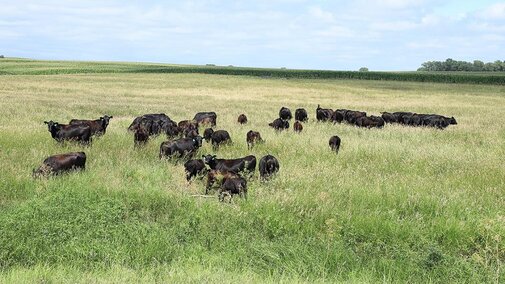The Right Stocking Rate
Stocking pastures with the right number of animals is one of the cornerstones of proper grazing management. It’s tempting to take the easy route and keep using the same rate year after year. After all, if it’s not broke, why fix it? But over time, could this approach do more harm than good.
While we might be aware of the importance of proper stocking, we may fail to properly adjust rates to match the current reality of our operation. Proper stocking depends on two factors — animal intake and pasture productivity. Changes to either of these factors — even if they take place so slowly, we don’t notice — can throw the balance off.
Production can change for the worse or better. Improving management practices like resting pastures, fertilization or improving distribution may have improved production and led to understocking over time.
On the flip side, prolonged overgrazing or encroachment of invasive species like leafy spurge or cedar trees can eat away production. It is estimated that a single cedar tree with an eight-foot diameter could reduce forage production by three pounds. If you had a density of 200 trees per acre, that would translate into nearly a one-third loss in forage production because of the effects of area coverage, moisture use and shading.
When we look at the demand side, animal size has a direct correlation with consumption. So, a 1,400 lb. cow will naturally need to consume more than a 1,200 lb. animal. While this difference may seem small (5.2 lb. of air-dried forage per day), this quickly adds up across the herd and over the grazing season. Add on top of that increased demand from high milk and production genetics we’ve selected for over time and it’s safe to say the average cow today consumes more forage than its counterpart 20 years ago.
Spring Turn-out to Pastures
The time for turn-out to our primary summer pastures is coming soon. A couple of important questions are what date to turn-out, and which pastures should be first?
The driving factors on the amount of grass growth at a specific date varies each year depending on spring temperatures and precipitation. This spring, March and April temperatures have been below normal and nearly all of Nebraska is at some level of drought. With the potential for ongoing drought, delaying turn-out and continuing to feed hay, if possible, is recommended. This will allow the grass plants to maximize growth given the current soil moisture conditions and result in greater season-long production.
For mixed cool- and warm-season native grass pastures, it is important to allow the cool-season grasses to reach at least a three-leaf stage. Initial grass growth in the spring comes from energy reserves stored in the roots and crowns of the grass plant. Grazing too soon could cause a depletion of those reserves and reduce production because there was not enough leaf area present to adequately begin producing energy from photosynthesis.
When grazing multiple native grass pastures in a rotation, it is beneficial to change the sequence or order of grazing for the set of pastures. This change in the time of grazing each year benefits the overall health and vigor of the grasses. For producers who have both native range and introduced grass pasture such as smooth bromegrass or crested wheatgrass, grazing the introduced grass pastures first is a great approach to use that resource and allows for a later turn-out on the native pastures.
An Animal Unit
Accurately determining animal grazing demands on a pasture is half of the process to setting a proper stocking rate. When the same animals are used year after year, this can be fairly straightforward. However, when class of animal changes (running yearlings instead of pairs), reproductive stage (fall calvers instead of spring) or even new animals (1,200 lb. cow pairs instead of 1,400 lb.), the change can be difficult to account for and compare. Using a common denominator such as the animal unit can help.
An animal unit or AU is the amount of forage consumed by a 1,000 lb. animal. Because animals don’t eat all their food instantaneously, we pair animal units with varying time periods for practical use. So, we can have animal unit days (AUDs), animal unit months (AUMs) and animal unit years (AUYs). While there is some debate on how much forage this is, the Society for Range Management and University of Nebraska use the amount of 26 lb. of oven-dried forage consumed per day.
So how does knowing this help us determine stocking rates for different groups of animals? Because AU are based on weight, we can scale up or down consumption over time by knowing the average weight of the animals we plan to graze. A 1,200 lb. cow will consume 31.2 lb. of dry forage daily while this increases to 36.4 lbs. per day for a 1,400 lb. cow. and decreases to just 18.2 lbs. of forage daily for a 700 lb. yearling.
We can also adjust for reproductive stage. A 1,200 lb. cow with calf will consume more forage early on due to lactation demands and slowly decrease while calf consumption increases closer to weaning. If we average it out, we can figure a pair with a 300 lb. calf at weaning will consume 1.5 AU worth of forage. Compare this to a 1,200 lb. fall calving, dry cow that is only eating for herself who is 1.2 AU and for which we have reproductive stage accounted.
Adjusting stocking rates to meet the reality of animal demand can be intimidating, but by using a common factor like animal unit, the adjustment can be made easily and without too much paperwork. Just make sure to compare similar time periods and adjust for animal size.

